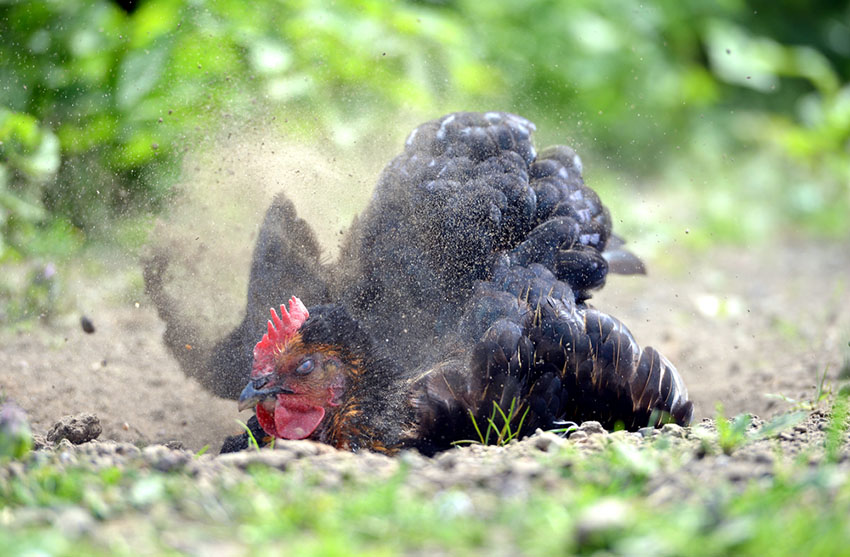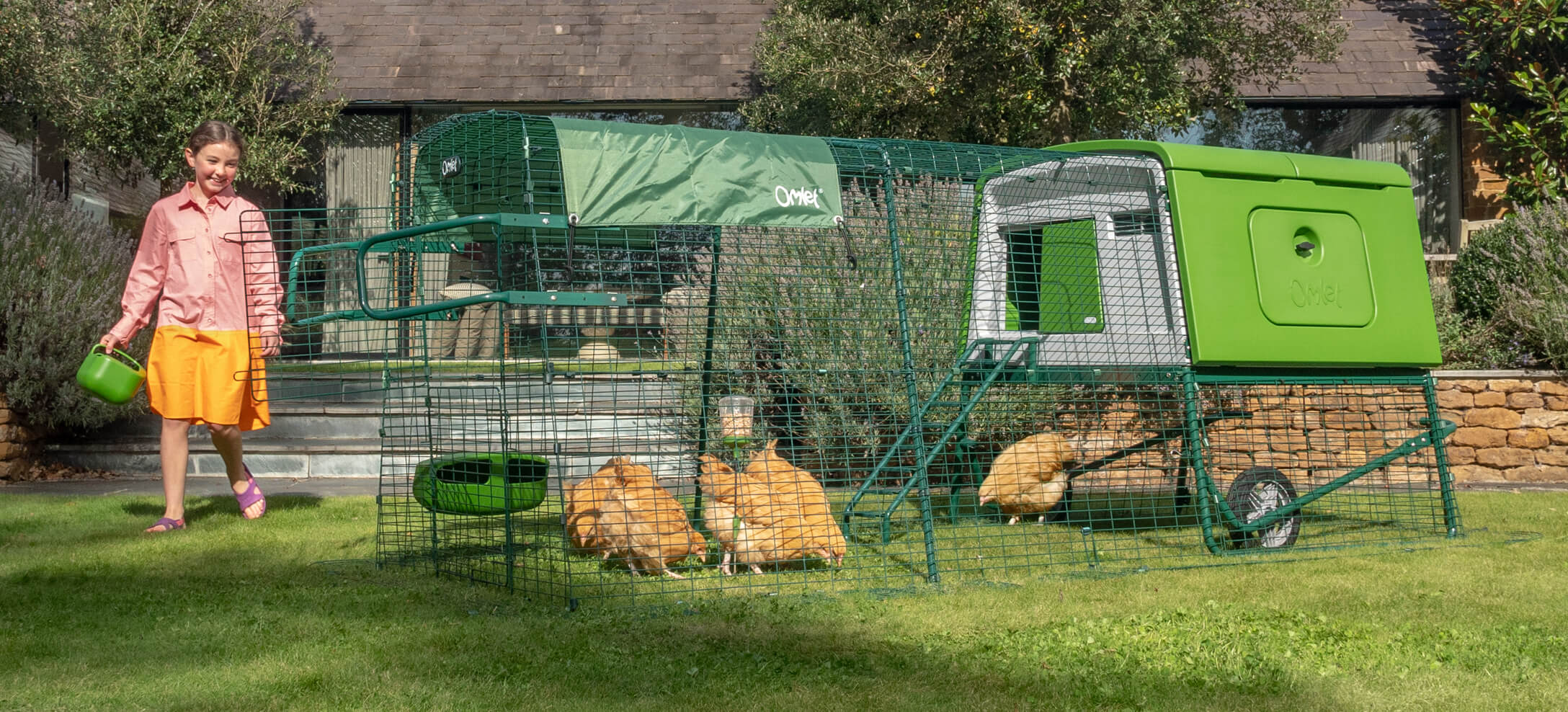Signs of heatstroke in chickens
Summer is a great time to enjoy your chickens. But along with the summer fun comes sweltering heat and high humidity for many chicken keepers. Being aware of the signs of heatstroke in chickens can keep your flock safe and enable you to enjoy the warmer months along with them.
Table of Contents
What is chicken heatstroke?
Heatstroke is what animals, including chickens, can experience when they become overheated to the point of it causing internal organ failure. Also known as heat exhaustion, heatstroke in chickens is more than just a hot hen — it’s the result of their body temperatures being elevated beyond a safe level for an extended period of time. Chickens that are too hot for too long simply can’t cool themselves anymore, and will succumb to heat exhaustion. When not treated properly and promptly, heatstroke can quickly become fatal to any affected hens. It’s important to help your chickens stay cool in the summer to avoid their body temperatures reaching this dangerous level.
Are any chicken breeds more susceptible to heatstroke?
Some breeds of chickens are more heat tolerant than others. The breeds that tend to not fare as well in hot climates are those that are bred primarily for meat such as Jersey Giants, and Delewares. Most egg-laying breeds of chickens do well in the hot weather as long as they have the right provisions — though some may need a little more support than others.
Silkies are a breed that doesn’t thrive in hot weather. This is largely due to their unusual feathers, as they can’t circulate air as proficiently as their regular-feathered cousins. Their head plumage can also obstruct their vision, making it more difficult for them to find water readily. Heavy breeds like Brahmas and Orpingtons may also struggle more in the heat due to their size.
Heat hardiness also depends on where chickens are raised. Hens that are adapted to the heat will fare much better than those that were relocated from a cooler climate to a warmer one. If you’re adding new chickens to your flock and experience intense heat in the summer, it’s best to obtain hens that are already accustomed to the warmer temperatures.
How to prevent chicken heatstroke
The old adage “an ounce of prevention is worth a pound of cure” is applicable when protecting your flock from heatstroke. One of the most important methods of keeping your hens cool in the heat is proper coop ventilation. Traditional wooden coops get stuffy and humid, keeping hens hot and uncomfortable. This can spell trouble quickly when the temperatures rise.
The Eglu Cube chicken coop by Omlet provides ample ventilation to move cooler air into the coop, which helps keep the internal temperature down. You’ll also want to provide as much shade as possible in your chickens’ run. This will help keep their body temperatures down, as well as keeping water sources cooler. Other preventative measures to combat heatstroke in chickens include:
- Providing plenty of fresh, cool water
- Letting your chickens dust bathe
- Offering frozen treats like corn or other chicken-safe vegetables
- Adding electrolytes to their water
- Frequently checking in on your flock to see how they are faring
6 signs of heatstroke in chickens
Recognizing heatstroke in chickens quickly can make all the difference when treating it. Overheated chickens need prompt care in order to make a full recovery, so be on the lookout for the following signs of heatstroke in your flock.
1. Decrease in egg production
Chickens take their jobs of supplying eggs for your family seriously, so if they slow down or stop producing eggs then there is likely something amiss. Summertime is not part of the usual moulting season for chickens — which is the only natural reason for young (non-broody) hens to stop laying eggs. You should investigate the cause of any decrease in egg laying by your hens, especially in the summer months, as this can be a warning sign to your flock getting too hot.
2. Lethargy
Hens that aren’t willing to move, seem dull, or appear sluggish should be evaluated for heatstroke. When hens are merely resting they will be stirred easily by food or human contact. Lethargic hens may be slow to respond or refuse to get up for food or after a gentle nudge from their owner.
3. Panting
The open-mouthed breathing associated with dogs is actually a cooling mechanism employed by chickens as well. While chickens may not loll their tongues out of their mouths, they will pant with their beaks open. Panting for short periods of time is a natural response to the heat, but keep a close eye on your flock if you notice panting. Offer cool water or frozen treats when you first notice them displaying this behaviour.
4. Increased thirst
Are your flocks draining their drinkers? It’s good for chickens to drink more water during the summer, but make sure their waterers stay full and clean. Chickens can become dehydrated quickly on a hot day, and if their thirst can’t be slaked they will deteriorate rapidly. If you notice that you’re filling your flock’s drinkers much more often than usual, it could be a sign that they’re getting too hot.
5. Reduced feed intake
Healthy chickens also take eating very seriously. Any hens off of their feed need to be checked thoroughly. Make sure your chickens have access to quality laying pellets at all times, and offer frozen treats and fresh fruits and veggies often during the summer. Scratch grains are best offered in the evenings, as these grains increase your chickens’ metabolisms, which causes their bodies to heat up. The amount you feed your chickens should not need to be adjusted in the warmer months, and you can expect healthy hens to go through the same amount of feed as they normally would. Many animals (chickens included) will naturally eat less during the warm months, but it should not make a significant difference to your flock’s feeder.
6. Wings outstretched
Chickens don’t have sweat glands, so they have to find creative ways to expel heat from their bodies. Panting is one way, but stretching their wings or holding their feathers more erect is another. This allows more air circulation around their bodies and through their feathers in an effort to bring their core temperature down.
All of these symptoms can be signs of chicken heatstroke, but they can also point to other problems that can plague your hens. Familiarize yourself with chicken ailments so that you’ll be able to differentiate between conditions that may require different treatments.
How to treat chicken heatstroke
Preventing heatstroke in chickens is the best way to combat it. But, should you find any of your flock presenting with symptoms of heatstroke, you’ll need to act quickly. And, if the following actions don’t have your hen improving, it’s time to call your veterinarian.
First, you’ll need to move any affected hens to a cool, shaded area. It may be tempting to bring them indoors, but cooling them down too quickly can actually cause them to go into shock — which can be lethal.
If your hen is conscious and compliant, you can fill a bucket with enough cool (not ice-cold) water to submerge them from their neck down. It’s very important to not use very cold water, as cooling a hot hen down too quickly can cause them to go into shock, which is often fatal. After this brief soak, place the hen in a cool, shaded area until they are acting normally once again.
Omlet and keeping your hens safe
The Eglu Cube chicken coop by Omlet was designed to keep your hens cool in summer and warm in the winter. We want hens all over the world to be comfortable all year round. By putting chicken run covers over your flock’s outdoor space and providing them with the twin-insulated Eglu Cube, both you and your birds will be able to get back to enjoying a carefree summer.
This entry was posted in Chickens



